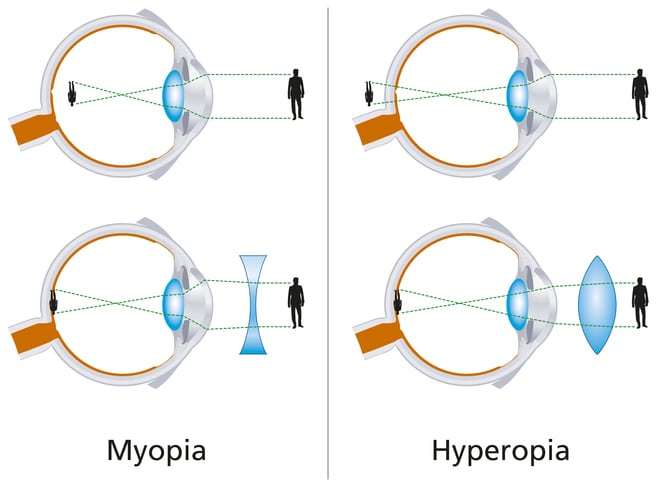Myopia vs hyperopia
Myopia vs hyperopia is a number of differences that differentiate both of the refractive errors in a prominent way. Their differences are given below:
Definitions and power in myopia vs hyperopia
The type of refractive error in which the image forms in front of retina is myopia. The overall power of the eye increases in myopia.
The patient sees near objects clearly and far objects with effort. It is also known as nearsightedness because myopes can see near objects clearly.
The type of refractive error in which the image forms behind the retina is hyperopia. The overall power of the eye decreases in hyperopes.
The patients see far objects clearly and feel difficulty while performing near work. It is also known as farsightedness because a hyperopes can see clearly at distance.

Far point position
The myopes have far point between the patients and far point of emmetropes.
The hyperopes have far point beyond the far point of emmetropes.
Pupillary reflex
While performing objective method of retinoscopy, WITH MOVEMENT reflex occurs in hyperopes and AGAINST MOVEMENT reflex occur in myopes. The reflex neutralizes according to the amount of refractive error a patient has.
Appearance of eyes
In myopia, the overall axial length of the eyeball increases and the eyes and cornea seem large.
In hyperopia the overall length of the eyeball appears shorter and the cornea also appears shorter.
Adverse side effects
Hyperopia
Hypermetropia can cause styes, blepharitis, chalazion, conjunctivitis due to constant rubbing of the eyeball as patient sees blur. The patients can have disturbed AC/A ratio. They are more likely to develop esotropia. Amblyopia is more common in children with hypermetropia than with myopia.
Myopia
The complications of myopia include defective vision, night blindness, degenerative changes in retina and optic disc, formation of myopic crescent, macular holes, posterior staphyloma, vitreous hemorrhage, nuclear sclerosis and cataract formation due to disturbance in lens metabolism cause by high myopia and retinal detachment.
Prescription of corrective lenses
The concave lenses are prescribed for myopes so that the image moves toward the retina.
The convex lenses or positive power lenses are prescribed for hypermetropia so that the image may form on retina from behind the retina.
Association with glaucoma
- Open angle glaucoma is more likely to occur in myopic patients.
- Angle closure glaucoma can occur in hyperopes as they have shallow anterior chamber angle.
Association with blindness
Due to severe complications which occur in degenerative myopia, it can cause legal blindness if it is not treated.
Accommodation lead and lag
The myopes generally exert more amount of accommodation than needed and they are in accommodation lead.
The hyperopes exert less accommodation than the normal range and that is why they are in accommodation lag.
Founder of EyesMatterMost- an optometry student who loves talking about eyes. I tend to cover topics related to optometry, ophthalmology, eye health, eyecare, eye cosmetics and everything in between. This website is a medium to educate my readers everything related to eyes.

